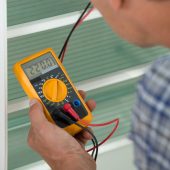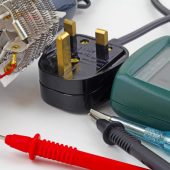Wondering how to measure DC current with a clamp meter? This guide is for you.
We discuss how to measure DC current using a clamp meter, what kind of clamp meter you need and important tips to keep in mind.
But first, a brief overview of what a clamp meter is and what you can do with it.
What Does A Clamp Meter Do?
The traditional way of measuring current or amps is using a multimeter. You touch the multimeter probes against the conductor to measure current flowing through it.
A clamp meter also measures current but without coming into direct contact with the conductor. Instead, you clamp metal jaws around an insulated wire.
The clamp meter detects the magnetic field created by flowing current to measure amps.
A clamp meter saves you the hassle of having to disconnect wires to measure current. It is also a safer way to measure live current.
Can A Clamp Meter Measure Voltage and Resistance?
Yes, a clamp meter can measure voltage, resistance and even continuity in addition to current.
However, there’s an important distinction in how you measure current and how you measure voltage and resistance.
The clamps on a clamp meter can only measure current. But most clamp meters also work as multimeters and come with the traditional red and black leads.
You can measure voltage, resistance, and continuity using the leads the same way you would with a multimeter.
If you buy a clamp meter with leads, you don’t need to also buy a multimeter.
Can A Clamp Meter Measure Both AC and DC Current?
Many of the digital clamp meters you’ll find in stores these days are AC/DC clamp meters, meaning they can measure both AC and DC current. There are also cheaper AC-only clamp meters.
Why can’t all clamp meters measure both AC and DC current?
That’s because AC and DC currents produce different kinds of magnetic fields.
An AC current changes direction 50-60 times a second depending on where you live (60Hz in North America, 50Hz in Europe and most of Africa and Asia).
As a result, a wire carrying AC current generates a corresponding alternating magnetic field. A clamp meter uses electromagnetic induction to generate a proportional current without coming into contact with the conductor.
A DC current flows in one direction. It creates a static magnetic field. The principle of electromagnetic induction in a clamp meter does not work if the magnetic field is static.
So DC current clamp meters need another way to detect the DC current magnetic field. They do this using a hall element.
A hall element uses the hall effect to generate voltage that is proportional to a magnetic field. In a clamp meter, the output voltage is then used to determine the value of the DC current.
That’s why clamp meters that can measure DC current are called hall effect clamp meters.
Tip: If you only plan to measure current in your home circuit, an AC-only clamp meter is enough. But if you have DC power sources like solar panels, a solar battery or a car battery, then a hall effect clamp meter is the best option.
How To Measure DC Current With A Clamp Meter
Here’s a step by step guide on how to measure DC current using a clamp meter. Remember to consult the user manual for instructions specific to your clamp meter.
1. Make sure you have the right kind of clamp meter
You need an AC/DC clamp meter to measure DC current. This is also called a hall effect clamp meter.
An easy way to tell AC-only and AC/DC clamp meters apart is by checking what lines appear above the A symbol on the dial.
An AC-only clamp meter will have a single wavy line above the A. An AC/DC clamp meter will have two lines above the A: a wavy line representing AC current and a solid straight line representing DC current.
In some clamp meters and multimeters, DC current can also be represented by the symbol A with solid and dotted lines above it.
2. Identify the conductor you want to measure
Before you set up the clamp meter, identify the conductor whose current you want to measure. You should only measure a single wire at a time.
Many electric cables contain several insulated wires inside. Measuring multiple wires at the same time will give you an incorrect reading.
You’ll need to isolate individual wires before measuring current. You can do this by removing a small section of the insulation to expose the wires (make sure you first turn off power to the wires either with a switch or by disconnecting the wires from the power source).
Once you’ve isolated individual wires, turn the power back on so that you can measure live current flowing through them.
3. Setting up the clamp meter
Before you measure DC current, there are a few more things you need to do.
One, disconnect the black and red leads from the clamp meter. You only need those for voltage, resistance and continuity measurements.
Second, turn the dial on the clamp meter to the AC/DC setting. The clamp meter will likely have several AC/DC settings like 20A, 100A, 400A and so on. Set the dial to the lowest figure that’s higher than the expected current to get a more accurate reading.
If you expect a current of about 10A, set the dial to 20A. If you expect a current of 150A, set it to 400A or whatever number is closest.
If you are not sure how many amps you expect, set the dial to the highest figure. Then once you measure, turn it down to figure that’s closer to the reading on the screen.
You can also set the dial to auto-ranging if your clamp meter has that feature. It’ll automatically set the right depending on the amps measured.
The third and final thing to do is zero the clamp meter. You only need to do this when measuring DC current.
That’s because the hall element in the clamp meter can produce voltage even without a conductor inside the clamps. It’s called an offset or unbalanced voltage.
If you don’t zero the meter, you’ll get an incorrect reading.
By the way, that’s another way to tell if a clamp meter can measure DC current. It will have a ZERO button on it.
Remember: The jaws of the clamp meter should be closed and no wire or conductor should be inside when zeroing the meter. Also, wait for the reading on the display to stabilise before you press the zero button.
4. Taking measurements
Now you are ready to measure DC current. Press the lever on the side to open the jaws, then clamp them inside the conductor.
Make sure the conductor is centred inside the jaws to get an accurate reading. Some clamp meters have marks to help you align the conductor properly.
Check the reading on the display. Press the hold button if you want the reading to stay on the display even after you remove the clamp meter from around the conductor.
If you are testing other wires, zero the clamp meter again and repeat the measuring process.
Remember to always keep your hand behind the tactile barrier on the clamp meter to avoid getting shocked.
Tip: If the display is difficult to read, check if there is a backlight button. Press it to brighten the screen.
Here’s an excellent video summarising most of what we’ve discussed.
Can You Measure DC Current With A Flexible Current Probe?
In some cases, the conductor you want to measure can be hard to reach or it’s too big for a regular clamp meter to close around it.
In that case, you can use a flexible current probe like the Fluke iFlex.
The problem is that, so far, I haven’t come across a flexible current probe that can measure DC current. All the ones I’ve seen only measure AC current.
This is probably because they don’t contain a hall element to measure DC current.
Even clamp meters like the Peakmeter Flexible Clamp Meter that come with a built-in flexible probe instead of the traditional rigid jaws only measure AC current.
If you cannot measure the amps in a conductor using a regular AC/DC clamp meter, it seems you’ll have to turn to other options like a digital multimeter.
How To Turn A Multimeter Into A Clamp Meter?
If you have a digital multimeter but want the safe non-contact current measurement provided by a clamp meter, there’s a way to do that without spending a lot of money on an AC/DC clamp meter.
Get a multimeter clamp meter adapter. One of the best ones online is the BTMeter BT-605A 600A DC/AC Current Clamp Adapter.
It’s an AC and DC clamp meter that connects to a digital multimeter using regular banana plugs. It measures AC or DC current and shows the reading on the multimeter display.


